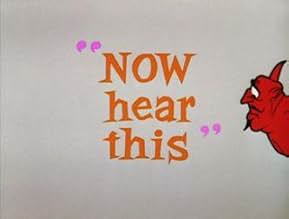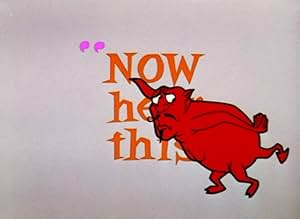Ajouter une intrigue dans votre langueIn this very abstract cartoon, a hard-of-hearing old Britisher finds a red horn and uses it as a megaphone, unaware that it is really a lost horn from the Devil's forehead. The Britisher fin... Tout lireIn this very abstract cartoon, a hard-of-hearing old Britisher finds a red horn and uses it as a megaphone, unaware that it is really a lost horn from the Devil's forehead. The Britisher finds that the horn has the effect of amplifying every sound psychedelically and causing him ... Tout lireIn this very abstract cartoon, a hard-of-hearing old Britisher finds a red horn and uses it as a megaphone, unaware that it is really a lost horn from the Devil's forehead. The Britisher finds that the horn has the effect of amplifying every sound psychedelically and causing him serious bodily harm.
- Réalisation
- Scénario
- Casting principal
- Nommé pour 1 Oscar
- 1 nomination au total
- Vocal effects
- (voix)
- (non crédité)
Avis à la une
The basic premise follows an elderly British man who mistakes one of Satan's horns as an ear trumpet and proceeds to fall into hijinks and chaos. With the right comedic timing and all the sound effects courtesy of legendary LT editor Treg Brown, this short could easily be a delight throughout. Unfortunately, what bogs it all down is how sluggish and labored the pacing becomes, making a lot of the surprises feel more off putting than funny. Outside of the variety of sound effects which do at least convey a lot in how they're utilized, much of the humor is executed through eye popping pop art, making the short feel too dated for its own good. As a result, much of what happens as a result of the hellish horn feels as made up as it goes along, with the so-called wacky nonsense feeling all over the place. Unlike any other cartoon where you empathize with the unfortunate victim in this circumstance while also being entertained by all the inventive trickery on screen, the short makes you feel sorry for the old man and wish he could get out of this nightmarish predicament.
If there is one notable quality that does actually pay off in the cartoon's favor, at least controversial musical composer William Lava made the most with the material. Lava's work in the later WB cartoons paled in comparison to the likes of Carl Stalling and Milt Franklyn as his trademark style favored experimental cutting edge tracks over classic vaudeville or jazzy bands. That being said, as this short goes all over the place in its execution, it actually allows for a lot of free range in the usage of musical instruments, conveying the tone a lot better than any of the writing or animation does. As mechanical and alienesque as Lava's work tended to sound in the later WB shorts, this one fully displayed his talent through careful planning and pay off. Also, the pantomime acting Chuck Jones was known for in a lot of his best work like Feed the Kitty and Mouse Warming lends itself well in how much emotional turmoil the old man is going through. Even at a time when the UPA influence in animation was still at play, albeit not so effectively, Jones was still able to lend his solid tropes well.
So despite an interesting concept and some fine details sprinkled throughout, Now Hear This fails as an experimental piece by indulging too much in its minimal grandeur. It should go without saying that while any animated short film has the right to go outside what is expected from casual viewers, it should at least understand what it's trying to accomplish while entertaining whoever is interested in it. If it's supposed to be for a niche market, it should at least know what is to be expected in the long run. Perhaps recommending this short is up to whoever lies in that type of field.
What impressed me so much about Now Hear This was how much material it fitted in such a short running time. The cartoon is just six and a half minutes or so, yet it has so many funny moments both visually and sound effects wise especially with the egg. This is all helped by the snappy pacing, Now Hear This does go very quickly without feeling rushed and there is never a dull moment.
The story of Now Hear This is a simple one, yet in its structure it is wonderfully abstract too. It wasn't just the material and pace that impressed me, the animation is wonderful with a great colourful stylistic look to it and very minimalist in style. The colours are audacious, the backgrounds are interesting and the characters are typical Jones in their design and when I say that I mean that in a good way.
The music is energetic and breezy, with the use of Mendelssohn's Spring Song never becoming annoying, a fun rendition of Yankee Doodle and a fun if bizarre variation of the Looney Tunes theme song. There are the sound effects as well, it isn't just the sound effects that make Now Hear This work, there are some truly great and creative sound effects and not one of them feel misplaced. Apart from one word, Quiet!, there is no dialogue, but that isn't a flaw in any way as it is the visuals and sound that drives Now Hear This.
All in all, a Chuck Jones masterpiece. 10/10 Bethany Cox
'Now Hear This' was the cartoon which first introduced the modern title sequence which would go on to be defiled by the Depatie-Freleng monstrosities. The most abstract cartoon Warner Bros. ever released, 'Now Hear This' is a clear forerunner for any number of surrealist animations from 'Yellow Submarine' to Bob Godfrey's superb 'Do-It-Yourself Cartoon Kit'. Having experimented with just about ever visual and narrative device available, with 'Now Hear This' Jones turns his attention to sound. The visuals here are minimalist, with highly stylised characters performing against a backdrop of nothingness. The cartoons begins with a frustrated devil searching for his missing horn (he wanders through the opening credits, showing a demonic contempt for convention). The horn is discovered by a stuffy English man (recognisable as English by his monocle and moustache even before the confirmation of a 'Keep Britain Tidy' sign and a burst of the British national anthem) who swaps his battered old ear trumpet for this new discovery. Thus begins his descent into aural hell! There is very little logic to the events of 'Now Hear This' but the images flow so beautifully that questioning them seems churlish. The impeccably chosen and synchronised bursts of sound (courtesy of genius sound man Treg Brown) are at once extraordinarily disturbing and this eerie edge to the cartoon cannot have escaped the attention of children's programmers since 'Now Hear This' was rarely seen on kid's TV. It is far more akin to the sort of cartoon I used to discover on TV at about 1am and then be haunted by for weeks for some indistinguishable reason. Like all such cartoons, 'Now Hear This' is utterly compelling and unpredictable. Testament to Chuck Jones's ongoing crusade to keep imagination alive, 'Now Hear This' is both a visual and aural treat.
While Chuck Jones was no stranger to experimentation (Just see Duck Amuck!), this is a considerable departure from his previous work, not only due its semi-abstract visuals (Though Jones's signature art style remains perfectly recognizable, especially in the demon's design), but also because of its dry, surreal sense of humor, feelling closer to the minimalistic films by UPA rather than Looney Tunes.
I guess such unusual approach might be the reason of its obscure status, though there is an undeniable cleverness displayed here, featuring a rather stylish aesthetic despite the limited animation.
No, it's definitely not Jones's best work, nor his funniest, but it's very interesting nonetheless.
Without a doubt, a product of its time (a difficult time, by the way, for Warner Bros animation) with a refined charm that will certainly appeal more to adult audiences (specially animation historians) than children.
Le saviez-vous
- AnecdotesThis was the first Warner Bros cartoon to use the "modern" Looney Tunes opening and closing sequence featuring stylized animation, an abstract WB logo, zooming "OO" in the word "Cartoon", swirling zooming lines (in place of the zooming shield), and slick lettering, on a black background, all to a "modern" rendition of the Looney Tunes theme ("The Merry-Go-Round Broke Down"). This title will also be used on four 1964 shorts ("Bartholomew Vs. The Wheel," "Senorella and the Glass Huarache," "Pancho's Hideaway" and "Road to Andalay,) and then every WB cartoon from 1965 to 1969.
- Citations
[the only spoken line]
Voice: QUIET!
Meilleurs choix
- Which series is this from: Looney Tunes or Merrie Melodies?
- List: Warner Bros. cartoons that were nominated for Academy Awards
Détails
- Durée6 minutes
- Mixage
- Rapport de forme
- 1.37 : 1
Contribuer à cette page





